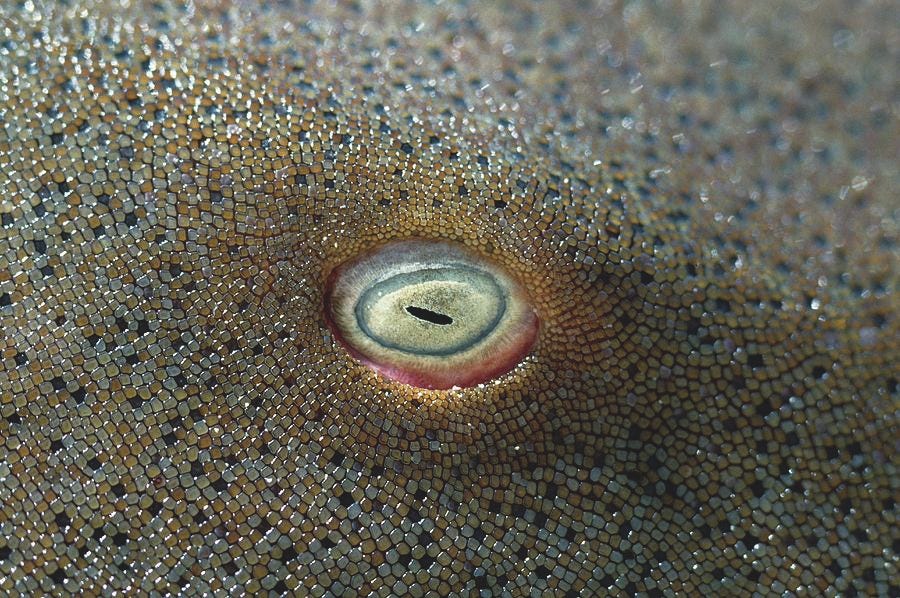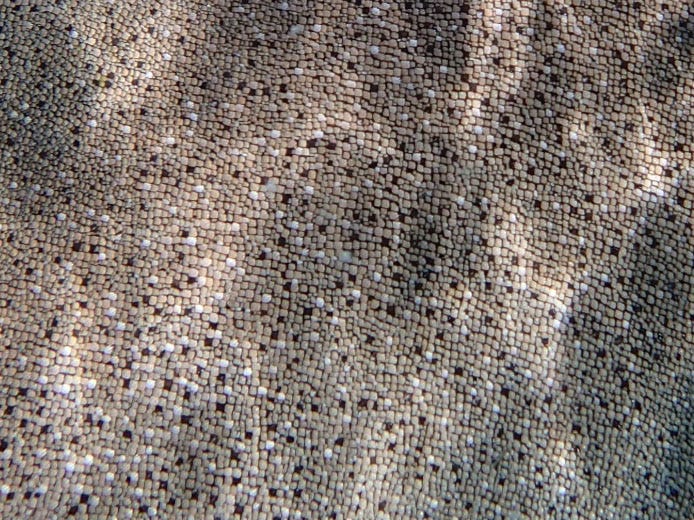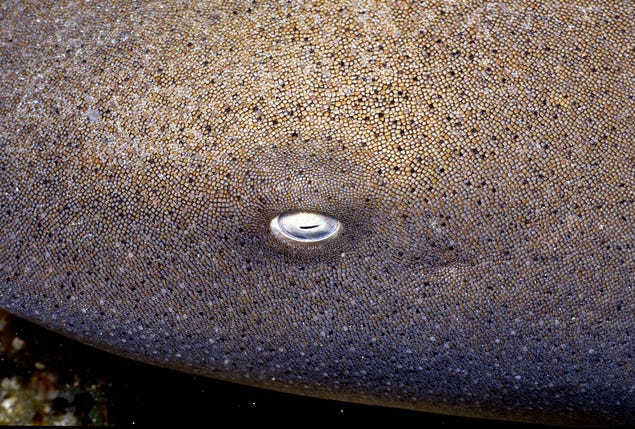The Atlantic has posted the winning images from the 11th annual Ocean Art Underwater Photo Contest. Several of these photographs are quite amazing — the two shots featuring sharks and smaller fish, the octopuses — but the standout for me is a close-up of a nurse shark’s eye.
I initially had trouble grasping exactly what I was looking at. If that is its eye — which does not really look like an eye from this short distance — then the orange, tan, etc. squares around it — which resemble tiles or colourful cobblestones — are the shark’s face or its head?
I searched for “nurse shark eye” (and “skin”) and found some high-res photos.
I’m trusting that this info about nurse sharks is accurate:
Known as the “couch potato of the shark world,” the nurse shark (Ginglymostoma cirratum) leads a sedentary life. By day, it rests, and by night, it creeps over the sandy floors and coral reefs of its shallow-water habitat, slurping up little animals along the way. . . .
For certain sharks, lying on the ocean floor is an impossibility. Species like the great white and the whale shark breathe by swimming nonstop; as they travel around, water is constantly flowing into their open mouths and across their gills, supplying oxygen en route. If the fish stop moving for too long, that flow ceases and they die. But other species are perfectly capable of breathing while sitting still—including the nurse shark. By using oral muscles to actively suck water into the mouth—what's called buccal pumping—it can supply oxygen to the gills without needing to swim anywhere.
Wild nurse sharks are usually found in shallow, coastal waters. The fish are nocturnal predators who tend to hunt within 65 feet of the ocean’s surface (although adults sometimes rest in deeper waters during the daylight hours). They spend their lives around coral reefs and coastal shelves, and most of their hunting takes place right on the ocean floor, where these slow-moving carnivores look for prey in or near the sand. Instead of swimming, they sometimes use their pectoral fins to “walk” across the bottom.
Barbels are fleshy sense organs that contain taste buds, which they drag across sand in search of prey. . . . A cavity within the throat generates a powerful suction which vacuums hapless animals up into the nurse shark’s mouth, where rows of tiny, backward-curving teeth crush up the food.
The mouth works like a dental conveyor belt; new rows of teeth pop up towards the back and gradually push older ones forward until they fall out. How long an individual row lasts depends on the season. During the winter, a nurse shark will acquire a fresh row of teeth every 50 to 70 days. But in the summer, tooth row replacement occurs every 10 to 20 days. . . .
Shark snuggle parties are a thing. By day, the nocturnal nurse shark becomes inactive; for hours on end, it just lies around and pumps water over its gills. Crevices, ledges, and piles of boulders are popular downtime locations for this species. Although the sharks don't socialize on hunting trips, they often recline en masse. Nurse sharks are known to rest communally, with groups of two to 40 individuals piling up on top of each other. . . .
[W]hy did people start calling this barbel-faced sea critter the “nurse” shark? That’s a linguistic mystery, but historians have their theories. Maybe the suction-based feeding methods reminded sailors of nursing infants. Alternatively, the nurse in nurse shark could be descended from “huss,” an archaic name given to an unrelated family of bottom-dwellers. (We now call them “catsharks.”) Over time, huss evolved into nuss, a word that came to mean “shark” or “large fish.” So perhaps the nurse shark moniker is based on a corruption of nuss. . . .
Because nurse sharks are sluggish by nature, commonly kept in aquariums, and don't possess large teeth, a lot of people who swim or dive in their natural habitat assume that the fish aren’t dangerous. But these predators can crush clams between their teeth and generate enough suction to rip a full-grown conch right out of its shell—so you don’t want one latching onto your arm. . . .
Nurse shark attacks are uncommon, but they’re certainly not unheard-of—and humans are usually to blame. YouTube is loaded with videos of scuba divers hugging, grabbing, or stroking wild nurse sharks. . . .
Also (ignore incorrect grammar):
Nurse shark can reach 7.5 to 14 feet in length and 200 to 330 pounds of weight. . . .
Nurse shark has strong jaws filled with thousands of small, serrated teeth. . . .
Nurse shark moves slowly, sluggishly and hunts alone. It ingests the prey by sucking it from the water. This is followed by unique slurping sound.
Nurse shark creates false shelter for crustaceans by using its own body (supported by fins). Once they enter the trap, nurse shark easily collects and eats them. . . .
Nurse shark doesn't migrate toward the warmer waters during the winter. It tolerates changes in the water temperature by decreasing its own activity. . . .
Nurse shark has an average lifespan of 25 years.









